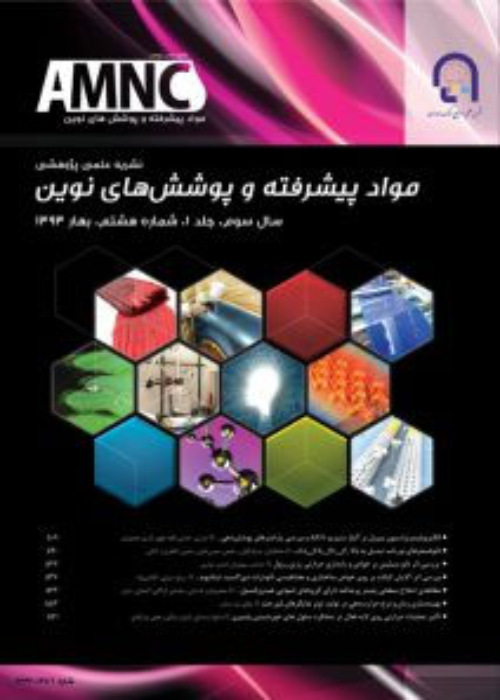فهرست مطالب
فصلنامه مواد پیشرفته و پوشش های نوین
پیاپی 3 (زمستان 1391)
- تاریخ انتشار: 1392/03/30
- تعداد عناوین: 7
-
-
صفحه 193
-
Page 159Increasing of regulations and warnings for conservation of environment and human well-being have clearly revealed a necessity of replacing new and non-toxic types of anticorrosion pigment. From the proposed compounds, zinc phosphate pigments have gained an appropriate spot among different industries, although there is a big gap between inhibition performance of zinc phosphate and chromate pigments. The changes in cationic, anionic or both parts of the primary zinc phosphate pigment have resulted in production of second and third generations of zinc phosphate pigment. In this paper, the anti corrosion pigments based on zinc phosphate and its new generations in different aspects of mechanism, synthesis, anticorrosion properties and characterization have been studied.Keywords: Anticorrosion pigment, Zinc phosphate, Synthesis, Organic Coatings, Environment
-
Page 177Surface morphology and structure of a nano-composite coating of Ni+RuO2 on Ni substrate were characterized by SEM, SEM-EDX, X-Ray Map. The Morphology observations by SEM revealed that the co-electrodeposited coating of Ni+RuO2 has a rough surface covered by cauliflower-like particles which distributed homogeneously on the Ni substrate. The bare Ni; however, has a partly smooth and porous surface. The presence of 3.62 %w RuO2 on the coating surface which diffuse less into the coating was confirmed by SEM-EDX. Study of the RuO2 particle size distribution in colloidal suspension by light scattering (LS) showed a homogeneous Gaussian distribution with no sign of agglomeration. The X-ray Map followed by image analyzing demonstrated a nonuniform nano particle size distribution below 100 nm on the coating surface. Additionally, the average RuO2 particle size of 527 nm in the suspension and 42 nm on the coating surface were measured. The coating activity was also enhamced with mechanical polishing compared with chemical etching according to linear sweep voltametry results. In the former the cathode surface was rough but uniform while in the lather a smooth surface was observed by SEM.Keywords: Active coating, Ruthenium oxide, Nickel, Co, deposition, Chlor, alkali cathode
-
Page 185The corrosion resistance of galvanized steel was evaluated by electrochemicalMethodspolarization and electrochemical impedance spectroscopy. The results confirmed the effect of zinc layer on the improvement of steel’s anticorrosive properties by cathodic protection and barrier effect. According to the polarization curves corrosion rate of normal steel and galvanized steel were calculate 180±5 μm/y and 85±5 μm/y respectively. Impedance resistances of galvanized samples were about 520±10 ohms, while it was 140±10 ohms for the normal samples. These results were within the results obtained by polarization curves. Also it was observed that the presences of a zinc layer can affect the cathodic reactions by reducing the cathodic slop of Tafel plots, so the corrosion protection mechanism of zinc layer can be the cathodic protection.Keywords: Galvanized steel, Cathodic protection, Corrosion, Electrochemical Impedance Spectroscopy, Polarization
-
Page 193School of Metallurgy and Materials Engineering, College of Engineering, University of Tehran, Tehran The paper intends to introduce innovations in the field of silane based coatings. Although the coatings are generally thin, they are able to provide a desirable corrosion protection. Hence, they could be taken into account as proper alternative for toxic chromate conversion coatings. In addition to protective action, silane layer can facilitate an excellent adhesion for the covering coating through covalent bonds. In spite of barrier properties, the coatings would fail to reveal active protection in case of introducing cracks or failures. Main aim of the paper is to introduce some novel approaches to improve protective performance of silane based coatings.Keywords: Silane, Adhesion, Corrosion protection, Corrosion inhibitors, Nano, particles
-
Page 205In this paper, Ag-doped ZnS thin films were deposited on glass substrates using radio frequency (RF) magnetron sputtering at room temperature. In order to optimization thin films, the samples deposited at various sputtering pressures (1.5×10-3 - 1×10-1 torr). The structure and surface morphology of the films were characterized by X-ray diffraction (XRD), atomic force microscopy (AFM) and scanning electron microscopy (SEM). Atomic absorption spectroscopy (AAS) and X-Ray microprobe analyzer (XPMA) were also employed. Findings showed that high-quality ZnS:Ag thin films with uniform morphology and chemical composition have been grown at 5×10-2 torr.Keywords: Sputtering, Thin film, Ag, doped ZnS, Characterization
-
Page 213The ZnO quantum dots (QDs) were successfully synthesized via co-precipitation technique and the effect of Mn2+ ions concentration as dopant on the optical properties was studied. To control the particle size by limiting the growth of the particles after the nucleation and to provide a side group on surface which can be further conjugated to bio-cell using polyethylene glycol (PEG) as bio-compatible capping agent. XRD analyses revealed single phase ZnO wurtzite crystal structure. TEM micrograph illustrates that the final QDs were about 10-30 nm in diameter with spherical shape. Also, the organic groups on the surface of nano-particles (NPs) were characterized by Fourier transform infrared spectroscopy (FTIR). From photoluminescence spectra, besides emission peak at 356 nm related to ZnO, doping Mn2+ ions in the host lattice led to appearance of the new visible emission band in the range of 410-450 nm because of 4T1→6A1 transition. Results show that the final QDs have potential for biochemical optical sensing.Keywords: Quantum dots, Zinc oxide, Surface modification, Biosensor, Photoluminescence, Doping
-
Page 219In this research, Chitosan-Cyanuric chloride hybrid (Ch-Cy) was applied onto wool fabric. The effect of significant factors such as Ch-Cy concentration, temperature and pH were evaluated on the grafting process. Scanning Electron Microscopy (SEM) and Differential Scanning Colorimetry (DSC) revealed the finishing of Ch-Cy onto wool fabric was carried out succesfully. The modified fabric was dyed with Reactive Red 195 and according to obtained R and K/S values of colored fabrics, the optimum values for operating variables determined which were CCh- Cy= 15% (owf), T=70 °C and pH=4-5. The results showed that the Ch-Cy improved the dyeing ability of wool and fastness properties of dyed modified fabrics indicated no significant differences compared to the untreated samples.Keywords: Chitosan, Chemical modification, Cyanuric Chloride, Wool, Dyeing properties


